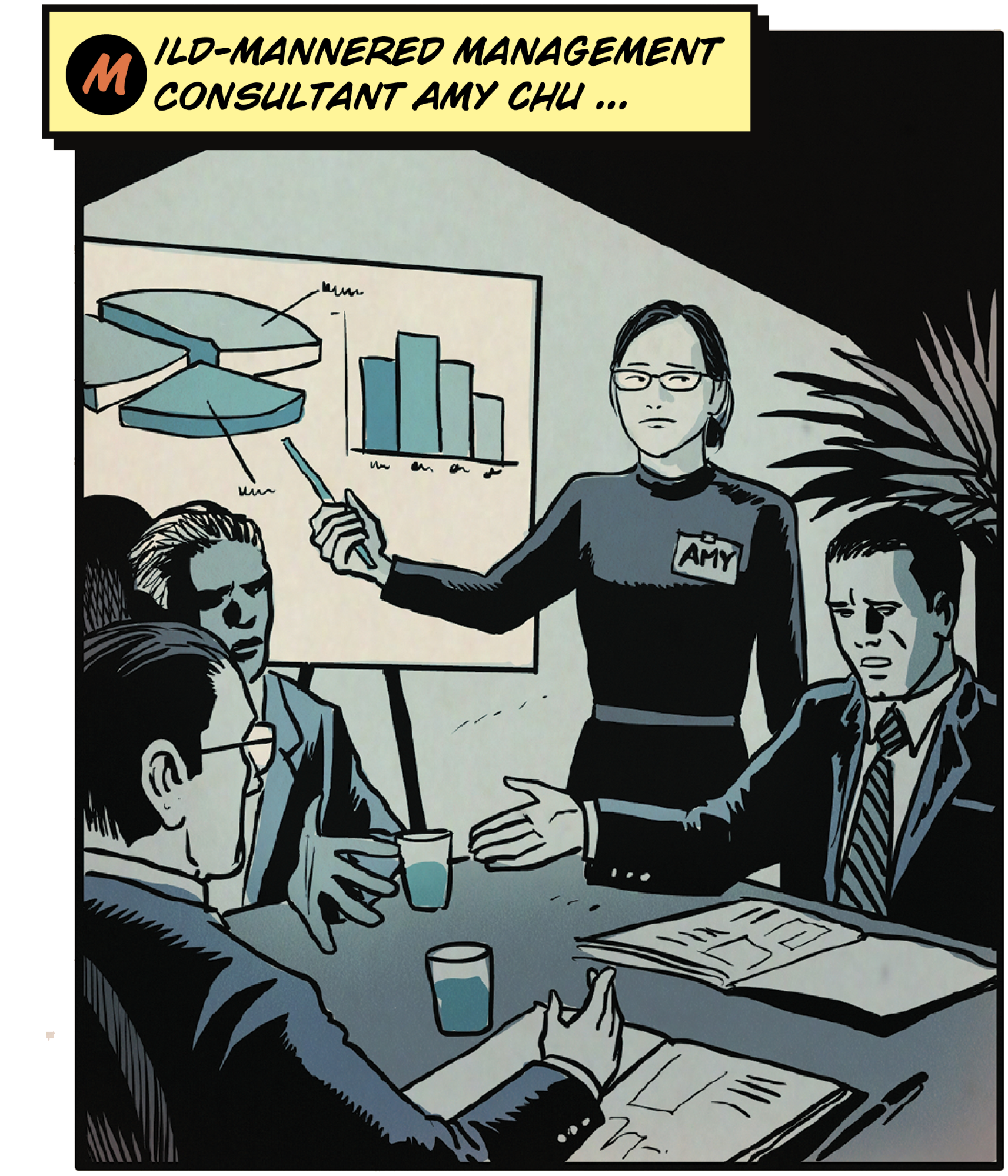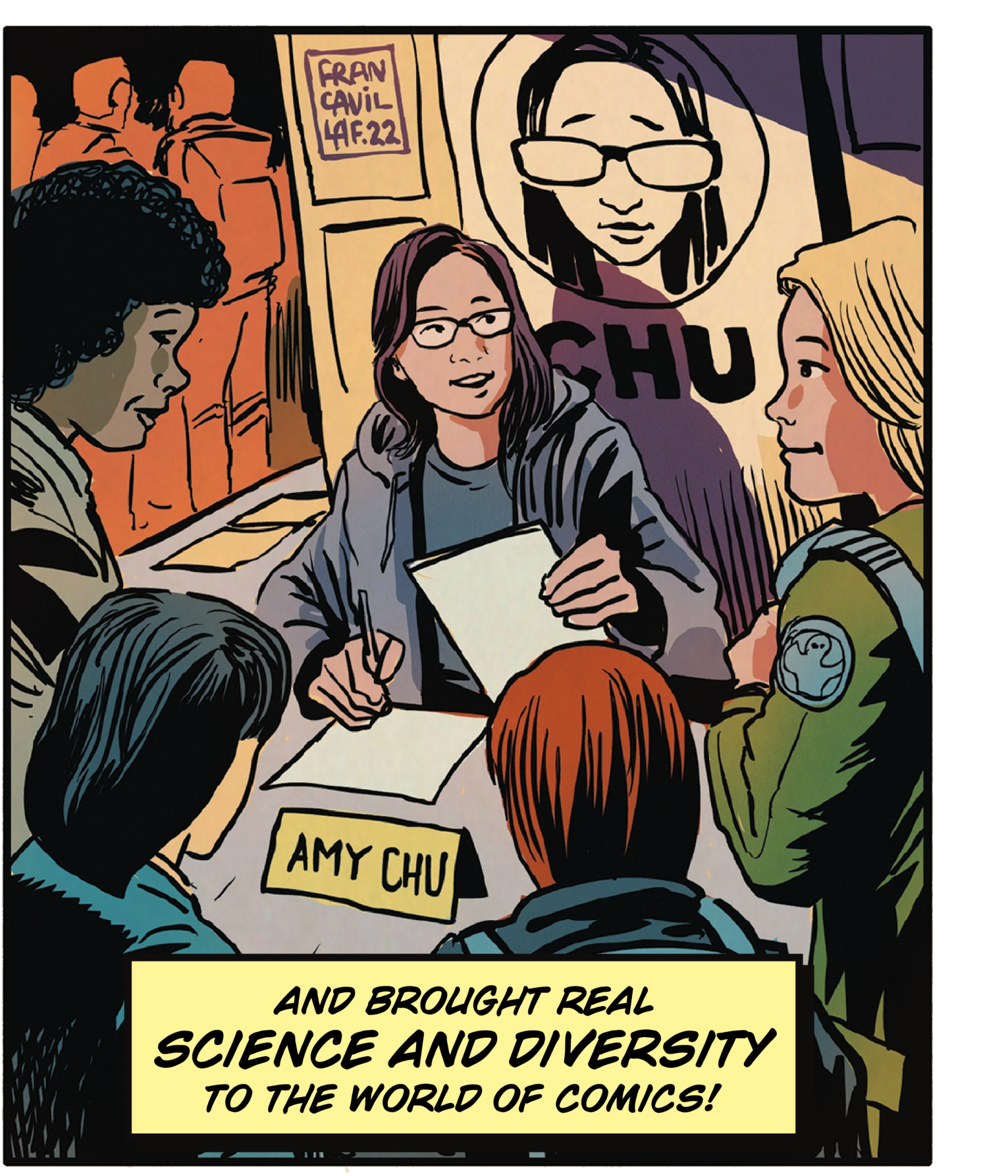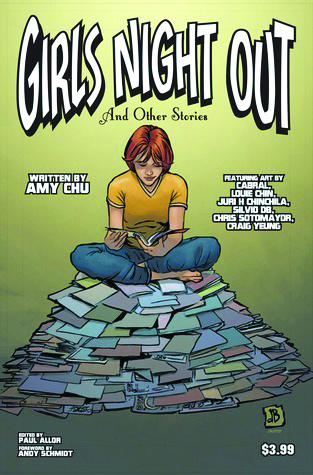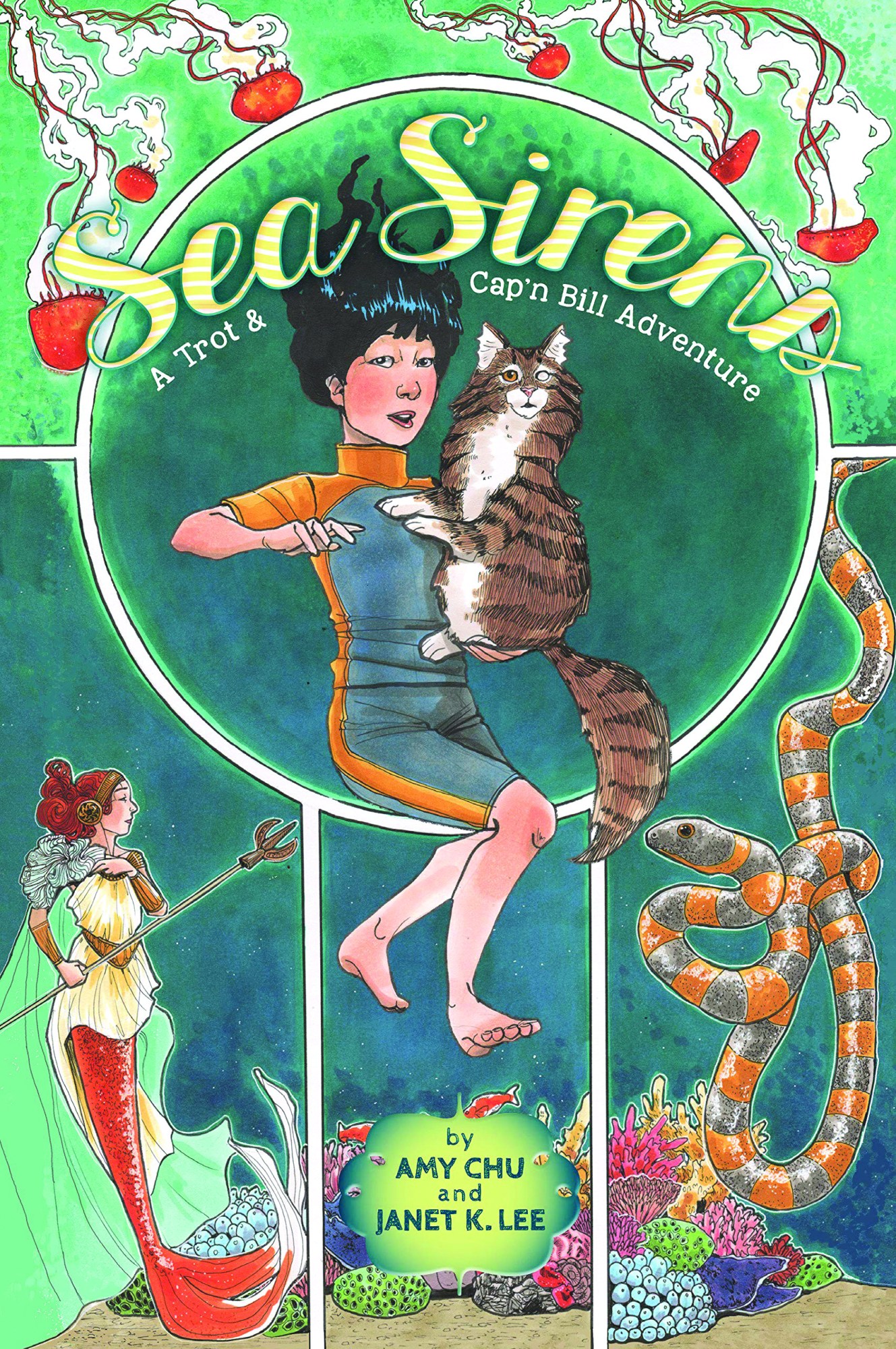Tech
Kapow!
Published
3 years agoon
By
Terry Power
Secreted beneath MIT’s Killian Court and accessible only through a subterranean labyrinth of tunnels, a clandestine lab conducts boundary-pushing research, fed by money siphoned from a Department of Defense grant. In these shadowed, high-tech halls, astrophysicist and astronaut Valentina Resnick-Baker, who is experiencing strange phenomena after an encounter with a planet-threatening asteroid, discovers she has the power of plasma fusion.
Resnick-Baker is the buff and brainy heroine of Summit, a 15-issue comic series created and written by Amy Chu ’91. The situations may be fictional, but the science is—broadly—real. (Chu did background research on plasma physics for the series, and when writing about the Batman villain Poison Ivy, she learned the basics of CRISPR so Ivy could deploy it to develop her own plant “kids.”) “The thing that has bothered me for a long time is that a lot of superhero stories are based on complete nonsense,” says Chu, 54. “Every story I do I try to ground in science.”
That a graduate of MIT prefers scientific plausibility to Kryptonite and radioactive spider bites may be the least surprising thing about Chu. At age 42, after a successful career spent largely in conference rooms, this erstwhile management consultant entered her own alternate universe as a comic book writer. First through her publishing startup, Alpha Girl Comics, and now through work for heavyweights like Marvel and DC, Chu is reimagining a traditionally white male medium for girls, Asian-Americans and Pacific Islanders, and others who rarely see themselves in its color-saturated panels.
“A lot of superhero stories are based on complete nonsense. Every story I do I try to ground in science.”
Amy Chu
With comics, Chu is pursuing both a market opportunity and a social agenda, the latter familiar to the battle-scarred women of gaming. “All these people are screaming and hollering about comics: that they are dying because girls and women are killing them,” says Chu, referring to well-publicized misogyny directed at female creators and fans. “The future of comics hinges on the ability to get girls as readers.”



Making the team
Chu’s advocacy for women and girls began as advocacy for herself. Her parents, who immigrated from Hong Kong in 1968, moved the family around the country for her father’s positions in nuclear and, later, medical physics. In 1980 they ended up in Iowa City, where Chu balanced nerdy predilections (chess team, Dungeons & Dragons, text-based computer games) with a love of soccer. Her school had only a boys’ team, which she made—but the coach wouldn’t let her play. Chu’s family sued the school district and won.
In 1985 Chu moved to Massachusetts and embarked on a dual-degree program that required her to divide her time between MIT, where she studied architectural design, and Wellesley, where she pursued East Asian studies. But it was at MIT’s Phi Beta Epsilon fraternity that she met her destiny. Chu’s boyfriend at the time was a member there, and the girlfriend of one of his friends had been storing a large box stuffed with comics at the frat. Many were from First Comics, an alternative publisher specializing in spies, adventurers, and science fiction. “I read almost the entire box that summer,” says Chu, who previously had equated comics with superheroes. “It was a revelation.”
That’s the origin story. But Chu’s career in comics was a long way off. At Wellesley she did dabble in publishing, launching a cultural journal to prod the creation of a class in Asian-American studies. And after graduating from Wellesley in 1989, she moved to New York to cofound A. Magazine, a general-interest publication for Asian-American readers. But Chu knew that a startup magazine was unlikely to make enough money to survive, so after about a year she returned to Cambridge to finish her MIT degree. (A. lasted another eight years.)
After senior jobs at several Asian-American nonprofits in New York, Chu spent two and a half years in Hong Kong and Macau. While overseas she worked for billionaire businesswoman Pansy Ho, who owned a PR firm that produced events for luxury brands, and also worked with her family’s business developing tourism in Macau. Ho became a mentor.
Chu returned to the US to attend Harvard Business School and in 1999, MBA in hand, boarded the management-consulting train. Two years at the strategic consultancy Marakon helped her retire some Brobdingnagian student loans. Then Ho asked Chu to assist a few of her biotech investments in the US. That touched off close to a decade of business trips and PowerPoints, with Chu working as an independent consultant for Ho and others. “There was a great need at that time for biotech Red Sonjas,” she says, referring to the flame-haired mercenary about whom she also has written.
By 2010, Chu was burnt out. Not only was her work intense, but she was raising two young children and exhausted from treatment for breast cancer. At the first Harvard Asian-American Alumni Summit, she connected with Georgia Lee, a friend who had engineered a 180-degree turn from consulting to writing and filmmaking. Lee laid out her new vision for a comics publisher targeting girls and women. Back then, female characters in established comics were reduced largely to cleavage and catsuits for the eyes of a presumed male readership.
The paucity of comics created by and for women awoke the sense of unfairness that had driven Chu back in Iowa. “I made the team in soccer,” she says. “I would make the team in comics.”
Becoming a writer
Chu and Lee’s startup, Alpha Girl Comics, debuted with a sci-fi Western by Lee called Meridien City. The founders planned to release work by other women later. As Chu prepared to take on the role of publisher, Lee urged her to learn every aspect of the business. So Chu signed up for a comic writing and editing program created by a former Marvel editor. “That’s where I got hooked,” she says.
Shortly after Alpha Girl released its first title, Lee couldn’t pass up the opportunity to direct a film in Hong Kong. By that time, Chu had written some stories of her own. “The whole thing shifted over to me,” she says. “So I said, I guess I will publish my stuff, with a bunch of artists.” (Like many comic writers, Chu crafts stories and collaborates with artists who draw the panels.)
Though her background doesn’t scream “comics creator,” it actually prepared her well for the work, she says. From the soulless labor of PowerPoint generation during her consulting career, she mastered economy of storytelling. And architectural design, her major at MIT, taught her to optimize space within constraints. (Chu compares fitting a full-blown fight scene into a 10-page comic to fitting a grand piano into a studio apartment: “You have to sacrifice things or it will be a bad experience.”)
For Alpha Girl, Chu wrote and produced two titles. Girls Night Out is a three-volume series that follows the adventures of a woman with dementia and her friends, who abscond from a nursing home. VIP Room is a one-off horror tale about five strangers imprisoned in a mysterious place. But hustling sales at conventions—Alpha Girl’s chief form of distribution—did not pave a path to prosperity. To raise her industry profile and make a little more money, Chu became a pen-for-hire, spinning new adventures for pop-culture icons developed by Marvel, DC Comics, and other publishers.



Chu’s decade-long career in comics has included a venture in independent publishing, graphic novels for young readers, and contemporary re-imaginings of the industry’s most iconic characters.
One notable creation was the story arc she developed in 2016 for Poison Ivy, a Batman villain who’d debuted in 1966 as a plant-obsessed eco-terrorist. Chu rethought the character as she produced Ivy’s first solo series, taking a sympathetic approach to her complicated morality. After getting feedback during a Wonder Con panel about the scarcity of Asian-Americans in comics, she added a South Asian male lead, partly inspired by a Jain classmate from MIT. (“Jains are extreme vegetarians, which of course was very interesting to Ivy,” she says.) Comics, says Chu, give her “a platform to increase representation and diversity.”
Comics also provide her with opportunities to get a little silly. In 2016, Chu began writing about the popular character Red Sonja, transplanting the sword-wielding barbarian from a fictional country and epoch to modern-day New York City. A few years later, Dynamite Entertainment and Archie Comics asked her to create a limited-series crossover between Sonja and Riverdale’s favorite female teen frenemies. “I thought, that is so ridiculous I am just going to say no,” says Chu of what ultimately became Red Sonja & Vampirella Meet Betty & Veronica. “Then I thought, if I can do it and make it good, that is a testament to my ability.”
MIT inspiration
Chu soon became a sought-after writer and is often asked to provide a fresh perspective on characters that may have been conceived decades ago. Ideas come from all over, including MIT Technology Review, which Chu calls “grounded in science and forward-thinking.”
The Institute has proffered inspiration in other ways. At a Baltimore Comic Con where she was on a panel, Chu reconnected with Wisdom Coleman ’91. Coleman talked about his experiences as a combat pilot in Afghanistan and the women who served alongside him there. The lives of those women became the basis for Chu’s first Wonder Woman story, about a female pilot who wonders whether her own heroics are in fact the work of the Lady of the Golden Lariat. (They’re not.)
Characters like that female pilot and Resnick-Baker, the astrophysicist-astronaut at the heart of the Summit series, dress as Chu conceived them: like real women doing real work. Characters that Chu did not create, by contrast, often are rendered in the hypersexualized style she detests. There’s not much she can do about it. “A lot is dependent on the editor and the editor’s selection of the artist,” she says. One sign of progress, she observes, is the less exploitative approach of comic books targeting young audiences or produced by a growing cadre of female editors.
Chu sometimes will push back, as when an artist working on one of her books depicted Poison Ivy in a thong. “I literally was on a call where I walked them through the Victoria’s Secret catalogue and told them what would be appropriate,” she says. “Somewhere between bikini and boy shorts is what I was imagining.” (The artist made the change.)
Today Chu gets so much work from mainstream publishers that she lacks time for Alpha Girl, which has not released a new title in several years. (Lee went on to write for television, notably for the Syfy and Amazon Prime Video series The Expanse.) She wants to revisit Alpha Girl, but “I keep getting stuff where I am like, I have got to write that because it is pretty cool,” she says. “Green Hornet? Yeah, I want to write Green Hornet! Wonder Woman? Of course!”
Chu also has ventured into more traditional publishing. In 2019 and 2020 Viking released two volumes of Sea Sirens, a graphic novel for middle graders created by Chu and her friend Janet K. Lee, the Eisner Award–winning illustrator. Adapted from a 1911 underwater fantasy by Wizard of Oz author L. Frank Baum, Chu and Lee’s updated version reimagines the heroine, Trot, as a Vietnamese-American girl in Southern California. Her adult male companion is now a talking cat. “The idea of a young girl wandering around with a strange older man having adventures raises a lot of questions these days,” says Chu.
There are other demands on Chu’s time. Three years ago, she was recruited to write two episodes for the Netflix series DOTA: Dragon’s Blood, based on the popular video game. (A second, undisclosed Netflix program is in the works.) She’s also starting work on a comic series based on the Borderlands video games. On a different track, another MIT friend, Norman Chen ’88, who now runs the Asian American Foundation, recruited Chu to produce an overview of Asian-American history for grade-school students.
If Chu eventually does revive Alpha Girl, she may enjoy a new generation of readers and contributors. About 10 years ago the Girl Scouts created a Comic Artist badge, and Chu was flooded with requests to address the troops. “In a few years, a lot more women will have had this exposure,” she says. “If they are anything like me, they will get hooked.”
You may like

My senior spring in high school, I decided to defer my MIT enrollment by a year. I had always planned to take a gap year, but after receiving the silver tube in the mail and seeing all my college-bound friends plan out their classes and dorm decor, I got cold feet. Every time I mentioned my plans, I was met with questions like “But what about school?” and “MIT is cool with this?”
Yeah. MIT totally is. Postponing your MIT start date is as simple as clicking a checkbox.
COURTESY PHOTO
Now, having finished my first year of classes, I’m really grateful that I stuck with my decision to delay MIT, as I realized that having a full year of unstructured time is a gift. I could let my creative juices run. Pick up hobbies for fun. Do cool things like work at an AI startup and teach myself how to create latte art. My favorite part of the year, however, was backpacking across Europe. I traveled through Austria, Slovakia, Russia, Spain, France, the UK, Greece, Italy, Germany, Poland, Romania, and Hungary.
Moreover, despite my fear that I’d be losing a valuable year, traveling turned out to be the most productive thing I could have done with my time. I got to explore different cultures, meet new people from all over the world, and gain unique perspectives that I couldn’t have gotten otherwise. My travels throughout Europe allowed me to leave my comfort zone and expand my understanding of the greater human experience.
“In Iceland there’s less focus on hustle culture, and this relaxed approach to work-life balance ends up fostering creativity. This was a wild revelation to a bunch of MIT students.”
When I became a full-time student last fall, I realized that StartLabs, the premier undergraduate entrepreneurship club on campus, gives MIT undergrads a similar opportunity to expand their horizons and experience new things. I immediately signed up. At StartLabs, we host fireside chats and ideathons throughout the year. But our flagship event is our annual TechTrek over spring break. In previous years, StartLabs has gone on TechTrek trips to Germany, Switzerland, and Israel. On these fully funded trips, StartLabs members have visited and collaborated with industry leaders, incubators, startups, and academic institutions. They take these treks both to connect with the global startup sphere and to build closer relationships within the club itself.
Most important, however, the process of organizing the TechTrek is itself an expedited introduction to entrepreneurship. The trip is entirely planned by StartLabs members; we figure out travel logistics, find sponsors, and then discover ways to optimize our funding.

COURTESY PHOTO
In organizing this year’s trip to Iceland, we had to learn how to delegate roles to all the planners and how to maintain morale when making this trip a reality seemed to be an impossible task. We woke up extra early to take 6 a.m. calls with Icelandic founders and sponsors. We came up with options for different levels of sponsorship, used pattern recognition to deduce the email addresses of hundreds of potential contacts at organizations we wanted to visit, and all got scrappy with utilizing our LinkedIn connections.
And as any good entrepreneur must, we had to learn how to be lean and maximize our resources. To stretch our food budget, we planned all our incubator and company visits around lunchtime in hopes of getting fed, played human Tetris as we fit 16 people into a six-person Airbnb, and emailed grocery stores to get their nearly expired foods for a discount. We even made a deal with the local bus company to give us free tickets in exchange for a story post on our Instagram account.
Tech
The Download: spying keyboard software, and why boring AI is best
Published
2 years agoon
22 August 2023By
Terry Power
This is today’s edition of The Download, our weekday newsletter that provides a daily dose of what’s going on in the world of technology.
How ubiquitous keyboard software puts hundreds of millions of Chinese users at risk
For millions of Chinese people, the first software they download onto devices is always the same: a keyboard app. Yet few of them are aware that it may make everything they type vulnerable to spying eyes.
QWERTY keyboards are inefficient as many Chinese characters share the same latinized spelling. As a result, many switch to smart, localized keyboard apps to save time and frustration. Today, over 800 million Chinese people use third-party keyboard apps on their PCs, laptops, and mobile phones.
But a recent report by the Citizen Lab, a University of Toronto–affiliated research group, revealed that Sogou, one of the most popular Chinese keyboard apps, had a massive security loophole. Read the full story.
—Zeyi Yang
Why we should all be rooting for boring AI
Earlier this month, the US Department of Defense announced it is setting up a Generative AI Task Force, aimed at “analyzing and integrating” AI tools such as large language models across the department. It hopes they could improve intelligence and operational planning.
But those might not be the right use cases, writes our senior AI reporter Melissa Heikkila. Generative AI tools, such as language models, are glitchy and unpredictable, and they make things up. They also have massive security vulnerabilities, privacy problems, and deeply ingrained biases.
Applying these technologies in high-stakes settings could lead to deadly accidents where it’s unclear who or what should be held responsible, or even why the problem occurred. The DoD’s best bet is to apply generative AI to more mundane things like Excel, email, or word processing. Read the full story.
This story is from The Algorithm, Melissa’s weekly newsletter giving you the inside track on all things AI. Sign up to receive it in your inbox every Monday.
The ice cores that will let us look 1.5 million years into the past
To better understand the role atmospheric carbon dioxide plays in Earth’s climate cycles, scientists have long turned to ice cores drilled in Antarctica, where snow layers accumulate and compact over hundreds of thousands of years, trapping samples of ancient air in a lattice of bubbles that serve as tiny time capsules.
By analyzing those cores, scientists can connect greenhouse-gas concentrations with temperatures going back 800,000 years. Now, a new European-led initiative hopes to eventually retrieve the oldest core yet, dating back 1.5 million years. But that impressive feat is still only the first step. Once they’ve done that, they’ll have to figure out how they’re going to extract the air from the ice. Read the full story.
—Christian Elliott
This story is from the latest edition of our print magazine, set to go live tomorrow. Subscribe today for as low as $8/month to ensure you receive full access to the new Ethics issue and in-depth stories on experimental drugs, AI assisted warfare, microfinance, and more.
The must-reads
I’ve combed the internet to find you today’s most fun/important/scary/fascinating stories about technology.
1 How AI got dragged into the culture wars
Fears about ‘woke’ AI fundamentally misunderstand how it works. Yet they’re gaining traction. (The Guardian)
+ Why it’s impossible to build an unbiased AI language model. (MIT Technology Review)
2 Researchers are racing to understand a new coronavirus variant
It’s unlikely to be cause for concern, but it shows this virus still has plenty of tricks up its sleeve. (Nature)
+ Covid hasn’t entirely gone away—here’s where we stand. (MIT Technology Review)
+ Why we can’t afford to stop monitoring it. (Ars Technica)
3 How Hilary became such a monster storm
Much of it is down to unusually hot sea surface temperatures. (Wired $)
+ The era of simultaneous climate disasters is here to stay. (Axios)
+ People are donning cooling vests so they can work through the heat. (Wired $)
4 Brain privacy is set to become important
Scientists are getting better at decoding our brain data. It’s surely only a matter of time before others want a peek. (The Atlantic $)
+ How your brain data could be used against you. (MIT Technology Review)
5 How Nvidia built such a big competitive advantage in AI chips
Today it accounts for 70% of all AI chip sales—and an even greater share for training generative models. (NYT $)
+ The chips it’s selling to China are less effective due to US export controls. (Ars Technica)
+ These simple design rules could turn the chip industry on its head. (MIT Technology Review)
6 Inside the complex world of dissociative identity disorder on TikTok
Reducing stigma is great, but doctors fear people are self-diagnosing or even imitating the disorder. (The Verge)
7 What TikTok might have to give up to keep operating in the US
This shows just how hollow the authorities’ purported data-collection concerns really are. (Forbes)
8 Soldiers in Ukraine are playing World of Tanks on their phones
It’s eerily similar to the war they are themselves fighting, but they say it helps them to dissociate from the horror. (NYT $)
9 Conspiracy theorists are sharing mad ideas on what causes wildfires
But it’s all just a convoluted way to try to avoid having to tackle climate change. (Slate $)
10 Christie’s accidentally leaked the location of tons of valuable art 

Seemingly thanks to the metadata that often automatically attaches to smartphone photos. (WP $)
Quote of the day
“Is it going to take people dying for something to move forward?”
—An anonymous air traffic controller warns that staffing shortages in their industry, plus other factors, are starting to threaten passenger safety, the New York Times reports.
The big story
Inside effective altruism, where the far future counts a lot more than the present

October 2022
Since its birth in the late 2000s, effective altruism has aimed to answer the question “How can those with means have the most impact on the world in a quantifiable way?”—and supplied methods for calculating the answer.
It’s no surprise that effective altruisms’ ideas have long faced criticism for reflecting white Western saviorism, alongside an avoidance of structural problems in favor of abstract math. And as believers pour even greater amounts of money into the movement’s increasingly sci-fi ideals, such charges are only intensifying. Read the full story.
—Rebecca Ackermann
We can still have nice things
A place for comfort, fun and distraction in these weird times. (Got any ideas? Drop me a line or tweet ’em at me.)
+ Watch Andrew Scott’s electrifying reading of the 1965 commencement address ‘Choose One of Five’ by Edith Sampson.
+ Here’s how Metallica makes sure its live performances ROCK. ($)
+ Cannot deal with this utterly ludicrous wooden vehicle.
+ Learn about a weird and wonderful new instrument called a harpejji.
Tech
Why we should all be rooting for boring AI
Published
2 years agoon
22 August 2023By
Terry Power
This story originally appeared in The Algorithm, our weekly newsletter on AI. To get stories like this in your inbox first, sign up here.
I’m back from a wholesome week off picking blueberries in a forest. So this story we published last week about the messy ethics of AI in warfare is just the antidote, bringing my blood pressure right back up again.
Arthur Holland Michel does a great job looking at the complicated and nuanced ethical questions around warfare and the military’s increasing use of artificial-intelligence tools. There are myriad ways AI could fail catastrophically or be abused in conflict situations, and there don’t seem to be any real rules constraining it yet. Holland Michel’s story illustrates how little there is to hold people accountable when things go wrong.
Last year I wrote about how the war in Ukraine kick-started a new boom in business for defense AI startups. The latest hype cycle has only added to that, as companies—and now the military too—race to embed generative AI in products and services.
Earlier this month, the US Department of Defense announced it is setting up a Generative AI Task Force, aimed at “analyzing and integrating” AI tools such as large language models across the department.
The department sees tons of potential to “improve intelligence, operational planning, and administrative and business processes.”
But Holland Michel’s story highlights why the first two use cases might be a bad idea. Generative AI tools, such as language models, are glitchy and unpredictable, and they make things up. They also have massive security vulnerabilities, privacy problems, and deeply ingrained biases.
Applying these technologies in high-stakes settings could lead to deadly accidents where it’s unclear who or what should be held responsible, or even why the problem occurred. Everyone agrees that humans should make the final call, but that is made harder by technology that acts unpredictably, especially in fast-moving conflict situations.
Some worry that the people lowest on the hierarchy will pay the highest price when things go wrong: “In the event of an accident—regardless of whether the human was wrong, the computer was wrong, or they were wrong together—the person who made the ‘decision’ will absorb the blame and protect everyone else along the chain of command from the full impact of accountability,” Holland Michel writes.
The only ones who seem likely to face no consequences when AI fails in war are the companies supplying the technology.
It helps companies when the rules the US has set to govern AI in warfare are mere recommendations, not laws. That makes it really hard to hold anyone accountable. Even the AI Act, the EU’s sweeping upcoming regulation for high-risk AI systems, exempts military uses, which arguably are the highest-risk applications of them all.
While everyone is looking for exciting new uses for generative AI, I personally can’t wait for it to become boring.
Amid early signs that people are starting to lose interest in the technology, companies might find that these sorts of tools are better suited for mundane, low-risk applications than solving humanity’s biggest problems.
Applying AI in, for example, productivity software such as Excel, email, or word processing might not be the sexiest idea, but compared to warfare it’s a relatively low-stakes application, and simple enough to have the potential to actually work as advertised. It could help us do the tedious bits of our jobs faster and better.
Boring AI is unlikely to break as easily and, most important, won’t kill anyone. Hopefully, soon we’ll forget we’re interacting with AI at all. (It wasn’t that long ago when machine translation was an exciting new thing in AI. Now most people don’t even think about its role in powering Google Translate.)
That’s why I’m more confident that organizations like the DoD will find success applying generative AI in administrative and business processes.
Boring AI is not morally complex. It’s not magic. But it works.
Deeper Learning
AI isn’t great at decoding human emotions. So why are regulators targeting the tech?
Amid all the chatter about ChatGPT, artificial general intelligence, and the prospect of robots taking people’s jobs, regulators in the EU and the US have been ramping up warnings against AI and emotion recognition. Emotion recognition is the attempt to identify a person’s feelings or state of mind using AI analysis of video, facial images, or audio recordings.
But why is this a top concern? Western regulators are particularly concerned about China’s use of the technology, and its potential to enable social control. And there’s also evidence that it simply does not work properly. Tate Ryan-Mosley dissected the thorny questions around the technology in last week’s edition of The Technocrat, our weekly newsletter on tech policy.
Bits and Bytes
Meta is preparing to launch free code-generating software
A version of its new LLaMA 2 language model that is able to generate programming code will pose a stiff challenge to similar proprietary code-generating programs from rivals such as OpenAI, Microsoft, and Google. The open-source program is called Code Llama, and its launch is imminent, according to The Information. (The Information)
OpenAI is testing GPT-4 for content moderation
Using the language model to moderate online content could really help alleviate the mental toll content moderation takes on humans. OpenAI says it’s seen some promising first results, although the tech does not outperform highly trained humans. A lot of big, open questions remain, such as whether the tool can be attuned to different cultures and pick up context and nuance. (OpenAI)
Google is working on an AI assistant that offers life advice
The generative AI tools could function as a life coach, offering up ideas, planning instructions, and tutoring tips. (The New York Times)
Two tech luminaries have quit their jobs to build AI systems inspired by bees
Sakana, a new AI research lab, draws inspiration from the animal kingdom. Founded by two prominent industry researchers and former Googlers, the company plans to make multiple smaller AI models that work together, the idea being that a “swarm” of programs could be as powerful as a single large AI model. (Bloomberg)
